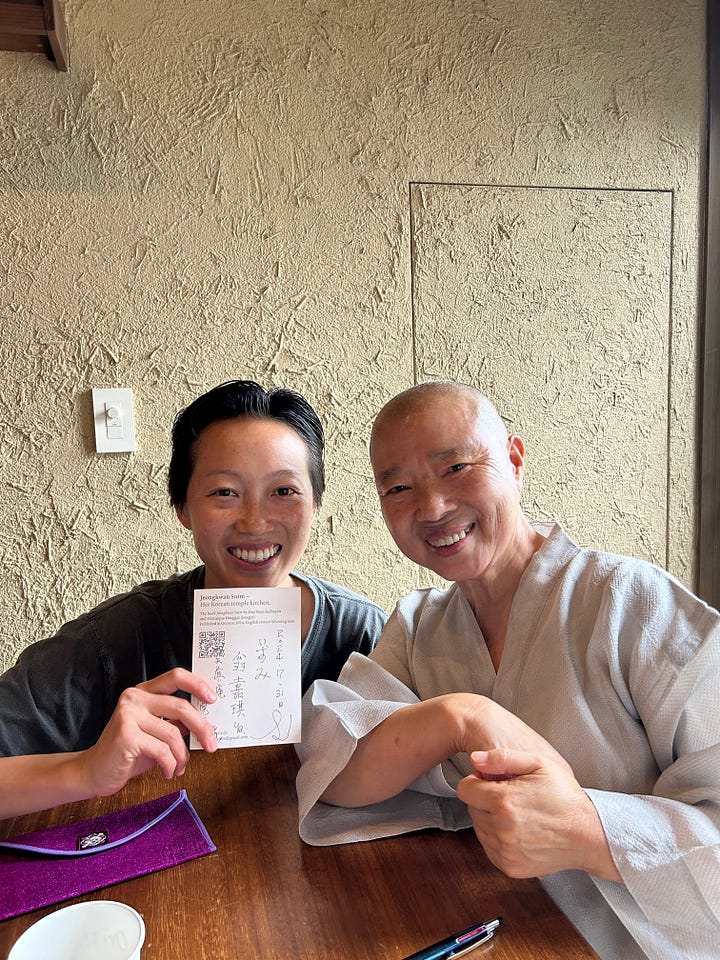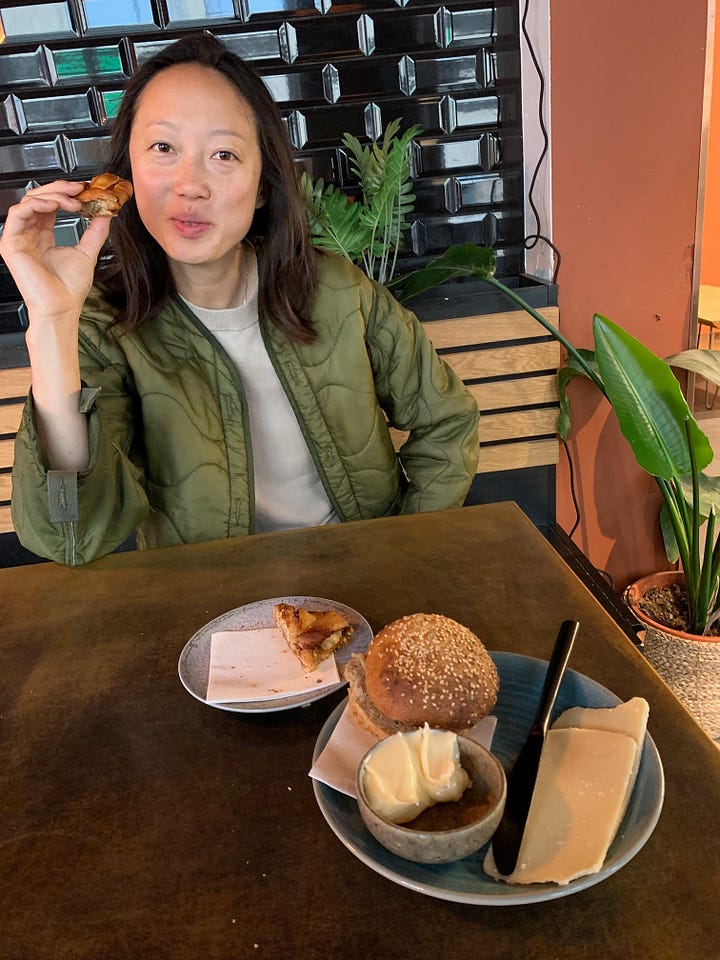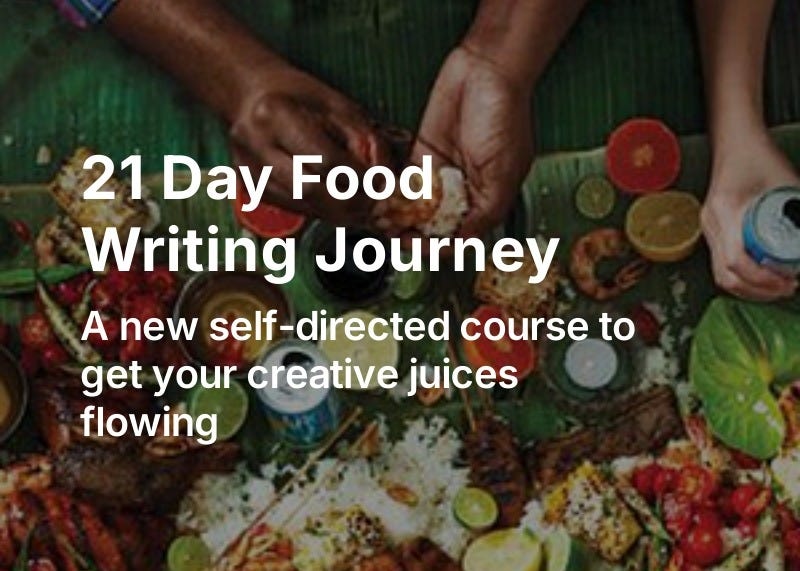Tastes Good with Jocelyn Ueng
Ten food questions with a world class chef and forager.
I met Jocelyn Ueng at an artist residency and was immediately enamored with her food stories. She is a Taiwanese-Chinese American chef who has traveled to 45+ countries! She sees food through a global lens and has cooked at the world's best restaurants, including The French Laundry, Satoyama Jujo, and most recently, noma.
Jocelyn’s food focuses on the micro-seasons, foraging, fermentation, and preservation. “It’s vital to consider these interconnected pieces as inputs to our ecosystem, our bodies, and our planet,” she says.
She is currently developing her own restaurant and plans to open it in spring 2026. Follow along on her adventures and creations on Instagram.
You can find our Q+A below.


Do you have an old family recipe that is a favorite?
My grandparent’s dried cabbage chili. It’s a labor of love, starting with sun-drying shredded cabbage on a bamboo basket, bringing it in each night and then out each morning over the span of two to three weeks. Once the cabbage is crispy dry, we rehydrate it for a few hours to pull out the rich umami and Maillard flavors developed from being in the sun.
Then the cooking process begins, starting with the wok over a high fire. We combine dried shrimp, garlic, sugar, sesame oil, soy sauce, oyster sauce, and more sugar. Once the base sauce is complete, next comes the rehydrated cabbage, and finally it’s finished with lots of red chili. The end result is a beautiful marriage of umami and spice, and perfectly tender, yet crunchy cabbage.
My grandfather passed in 2020, and my grandmother’s arthritis has gotten too severe for her to cook. As the chef in the family, I feel a sense of responsibility to perfect this recipe and carry on the tradition.
Which kitchen item is essential to your cooking?
An Ateco 4.5” kitchen offset spatula, an NT Cutter PRO stainless steel box cutter, Silky multi-purpose scissors, and my Yu Kurosaki 210mm Gyuto knife.
What food (or condiment) can always be found in your fridge?
Kewpie mayo.
How have you been able to maintain your love of cooking over the years while working in such intense kitchens?
Two elements have gotten me through the toughest days:
First, an incredible team. At noma, after spending 15 hours a day in a kitchen with 30 other chefs, you really begin to develop a deep bond with one another. Despite us all coming from different countries and cultures, we all shared an understanding of the mindset necessary to deliver a successful service. One must have a high drive, self-awareness, and self-motivation in order to survive in these high intensity/caliber kitchens. It was vital for us to build deep mutual trust, knowing that we had each other’s back if an issue were to arise (and they always do!). It was exciting to begin each day’s work knowing that we were all in it together.
Secondly, whenever I’m having a bad day or feeling burnt out, overwhelmed, anxious, or the occasional pangs of nihilism, I turn to Mother Nature to reconnect with food. Nature is my muse and greatest inspiration. The earth holds the purest beauty and treasures, and helps me return to myself, feeling grounded, refreshed, and rejuvenated. Nature’s greatest gift is its ability to provide, day in and day out, against all odds. When I remind myself of this simple yet grand philosophy, I’m able to return to my canvas, the kitchen.
What are you really proud to know how to cook?
A perfectly, pan seared fish.
What do you like about eating with the seasons and foraging?
While our Gregorian calendars force us into following a strict 4 quarter, 12 month schedule, Nature is made up of nuanced microseasons. In ancient Japan, they followed 72 microseasons called kō, adapted from China’s 24 season calendar. The 24 divisions are then each split again into three, for a total of 72 kō that last around five days each.
Each microseason has a name, which is based on a reflection that represents that time. For example, the third week of February is Tsuchi no shō uruoi okoru, or “the rain moistens the soil,” and the first week of March is Sugomori mushito o hiraku, or “hibernating insects surface.” Each microseason shows the small rhythms of nature and how each period passes and overlaps, reflecting life and death, all in a matter of 5 days.
In Buddhism, we value permanence within impermanence - meaning, everything will pass. Respecting this natural flow of life is instilled in me, as a chef, as a human, as a child of the earth. To understand this is one thing, to practice it is another. Turning to wild food and foraging is a way for me to practice impermanence and to abide by nature’s cycles.
Moreover, wild food is much tastier than farmed food! The access to nutrients that wild soil gets from natural decomposition is incomparable to any farming practice. In turn, wild vegetables, berries, mushrooms, weeds, nuts, grains, all carry flavors that have more depth, tannins, brightness, and umami.
What has food taught you about love?
Cooking for someone is an act of love. We all know about the five love languages, and making a meal for someone would fall under acts of service. Ever since I was a toddler, I’d always be in the kitchen closely observing my grandparents make dumplings and braises. I was enamored by the actions, speed, and the science behind it all. One of my core memories is playing with dough in the kitchen while watching my rambunctious cousins wrestle in the backyard. When I was six or seven, I remember asking my po po (maternal grandma) why she would use room temperature water for dumpling dough vs. hot water for bing (Chinese pancake) dough. I felt her love from the care and patience she had in explaining each step to me. And whether I fully understood it at the time or not, she knew that one day I would carry this love onto someone else.
What's the most unusual food you have tried? Was it delicious?
Live octopus at a Korean BBQ restaurant in Koreatown, Los Angeles. I was about 15 or 16 at the time. It was quite intense to watch the octopus get cut up into small pieces, table-side, and then watch its suckers cling onto the plate as we plucked each piece up with our chopsticks. Then, we had to chew it as fast as we could to ensure that the tentacles didn’t cling onto our throat, otherwise we’d choke to death! To be honest, all of this adrenaline and action blurred my memory of the taste…
How does eating alone make you feel?
I enjoy eating alone, especially when I’m traveling. When you’re in a foreign place, your senses are naturally heightened, and you’re more attuned to your environment (for safety and from excitement). Stepping into a new restaurant in an unfamiliar town already carries a sense of adventure; doing it alone, adds another layer to it. I’m able to pay closer attention to the food, flavor profiles, textures, and temperature, and I also become more engaged with the overall experience. Whether it be at a fine dining establishment or roadside stall, eating alone allows me to make a more meaningful connection with the people that are feeding me.
Any food questions you get asked a lot that you'd like to answer?
People always ask, “What was it like to work at noma and The French Laundry?” Well, there’s the respect for high art, stunning guest experiences, and of course, long and exhausting days. But what I often forget to share is how this impacted my day-to-day approach to life. Working in three Michelin star kitchens trains you to become well-equipped to handle any situation. I apply this philosophy to my personal life as well.
We used to joke in the kitchen that we should all be living three Michelin star lives (in the most humbling way). That is, treating your body with the utmost respect, working out, eating healthy, maybe running a marathon here and there. That is, checking in with friends and family, despite being thousands of miles away, so both parties can feel loved and connected. That is, treating your one precious life well, seeing the rarity and fragility of it all, and giving it all you got.
Find more of Jocelyn and her delicious food on Instagram.
Who should I interview next? Send me an email at ginarae@substack.com
Lots of love,
Gina Rae
Thanks for reading Feed Me Figs! If you enjoyed this post, please share it.
Want to answer your own food questions?
Join the 21 Day Food Writing Journey!
This course includes twenty-one days of simple writing prompts and exercises, delivered to your Inbox every morning. Sign up for this adventure to check in with yourself, process your emotions, and dream into your food future—all in less than 20 minutes a day.
You may even find that by the end of the course, you will have transformed your relationship with food and found new sources of nourishment.
Need extra support with a creative project or your writing?
Work with me one-on-one.
You can book a month of support here, or reach out to ginarae@substack.com if you have questions or would like to tailor a program that suits your needs.







